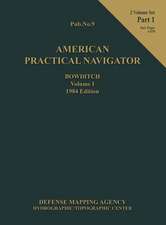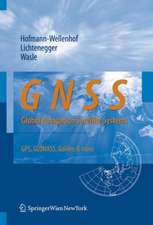Navigation: Principles of Positioning and Guidance
Autor B. Hofmann-Wellenhof Contribuţii de H. Lichtenegger Autor K. Legat, M. Wieseren Limba Engleză Paperback – 4 sep 2003
Preț: 594.24 lei
Preț vechi: 699.10 lei
-15% Nou
Puncte Express: 891
Preț estimativ în valută:
113.71€ • 119.02$ • 94.64£
113.71€ • 119.02$ • 94.64£
Carte tipărită la comandă
Livrare economică 31 martie-14 aprilie
Preluare comenzi: 021 569.72.76
Specificații
ISBN-13: 9783211008287
ISBN-10: 3211008284
Pagini: 464
Ilustrații: XXIX, 427 p. 29 illus.
Dimensiuni: 170 x 244 x 22 mm
Greutate: 0.7 kg
Ediția:Softcover reprint of the original 1st ed. 2003
Editura: SPRINGER VIENNA
Colecția Springer
Locul publicării:Vienna, Austria
ISBN-10: 3211008284
Pagini: 464
Ilustrații: XXIX, 427 p. 29 illus.
Dimensiuni: 170 x 244 x 22 mm
Greutate: 0.7 kg
Ediția:Softcover reprint of the original 1st ed. 2003
Editura: SPRINGER VIENNA
Colecția Springer
Locul publicării:Vienna, Austria
Public țintă
ResearchCuprins
1 Introduction.- 1.1 Goals and structure of the book.- 1.2 Definitions and terms.- 1.3 Quality parameters.- 1.4 Applications and phases of navigation.- 1.5 User requirements.- 1.6 Miscellaneous..- 2 Historical review.- 2.1 Origins of navigation.- 2.2 Hellenistic period and Roman Empire.- 2.3 Middle ages.- 2.4 Seventeenth and eighteenth century.- 2.5 Nineteenth and twentieth century.- 3 Mathematical fundamentals.- 3.1 Reference frames.- 3.2 Principles of position determination.- 3.3 Principles of velocity determination.- 3.4 Principles of attitude determination.- 3.5 Accuracy measures.- 3.6 Least squares estimation.- 3.7 Principles of routing and guidance.- 4 Physical fundamentals.- 4.1 Fundamentals of electromagnetic waves.- 4.2 Electromagnetic wave propagation.- 4.3 Observables from electromagnetic waves.- 5 Maps.- 5.1 Introduction.- 5.2 Types of maps.- 5.3 Map projections.- 5.4 Digital maps.- 6 Terrestrial navigation.- 6.1 Introduction.- 6.2 Instruments and observables.- 6.3 Position determination.- 6.4 Drift.- 7 Celestial navigation.- 7.1 Introduction.- 7.2 Astronomical basics.- 7.3 Celestial fix by spherical resection.- 7.4 Star tracker.- 7.5 Internet sources on celestial navigation.- 8 Terrestrial radio navigation.- 8.1 Introduction.- 8.2 Point source systems.- 8.3 Area-based systems.- 8.4 Aircraft landing systems.- 9 Satellite-based navigation.- 9.1 Introduction.- 9.2 Early systems.- 9.3 GPS.- 9.4 GLONASS.- 9.5 Galileo.- 9.6 Other satellite-based navigation systems.- 10 Augmentation systems.- 10.1 Introduction.- 10.2 Differential GNSS.- 10.3 Integrity monitoring.- 10.4 Examples of augmentation systems.- 11 Inertial navigation.- 11.1 Introduction.- 11.2 Sensors.- 11.3 Navigation equations.- 11.4 Platform alignment.- 11.5 Navigation performance.- 12 Image-based navigation.- 12.1 Introduction.- 12.2 Impacts on image-based navigation.- 12.3 Image sequence analysis.- 12.4 Image-based navigation techniques.- 13 Integrated navigation.- 13.1 Introduction.- 13.2 Advanced Kalman filtering.- 13.3 Principles of sensor fusion.- 13.4 Typical multisensor systems.- 14 Routing and guidance.- 14.1 Introduction.- 14.2 Route planning.- 14.3 Route guidance.- 15 Vehicle and traffic management.- 15.1 Introduction.- 15.2 Land-based traffic management.- 15.3 Maritime traffic management.- 15.4 Air traffic management.- 16 Application examples.- 16.1 Conventional applications.- 16.2 Specific applications.- 16.3 Other applications.- 17 Critical outlook.- References.
Caracteristici
FIRST BOOK THAT COVERS THE COMPLETE SUBJECT OF NAVIGATION ENCYCLOPEDICALLY • THE GENERAL APPROACH IS ELEMENTARY • DETAILS ARE PROVIDED FOR MOST URGENT PROBLEMS OF UNDERSTANDING, FORMULAS ONLY WHEN NECESSARY

















